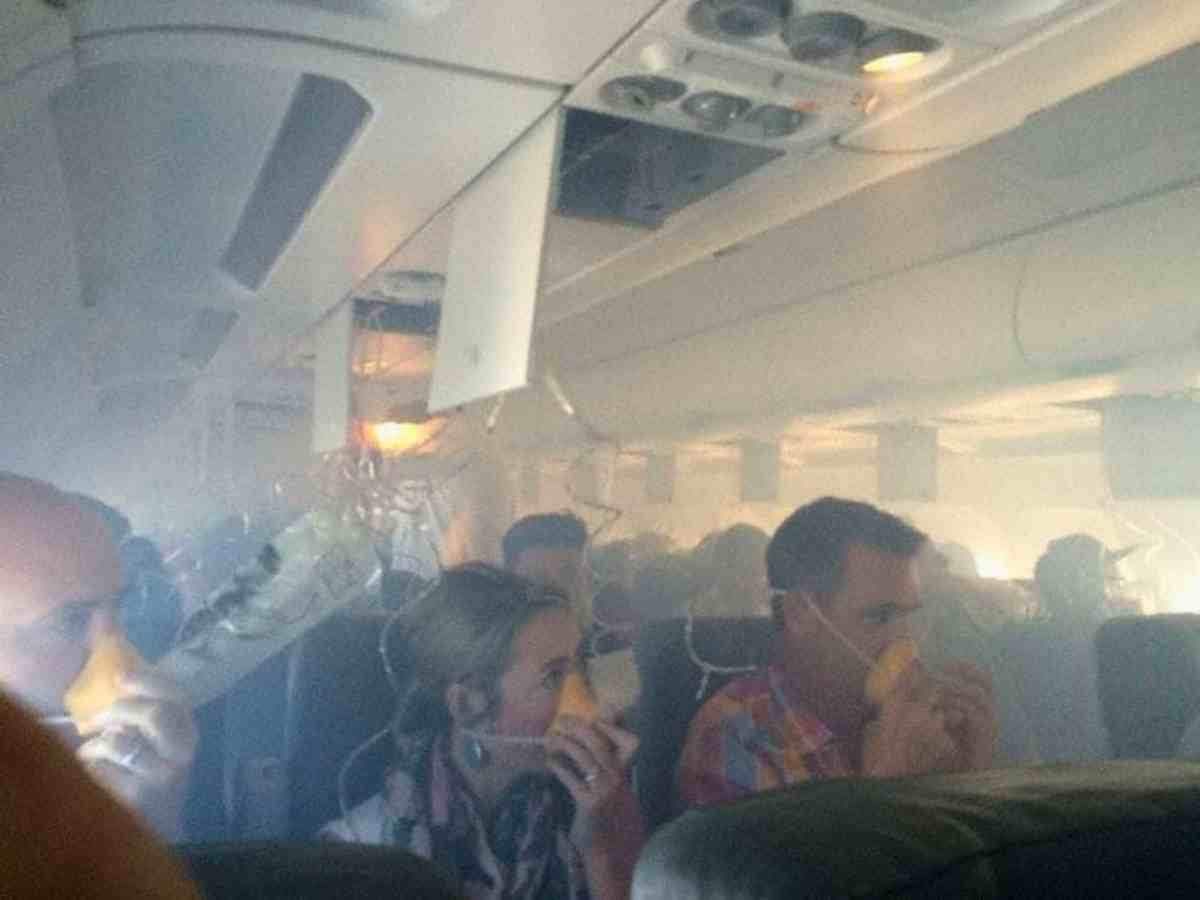Since the 1950s, fume events have impacted the health of thousands of pilots, cabin crew, and passengers globally, as toxic chemical compounds from the air supply, known as “bleed air,” contaminate the air in the cockpit and cabin. This is known as aerotoxic syndrome.
Synthetic engine oils and hydraulic fluids drawn from the engine or auxiliary power unit (APU) can leak into the aircraft breathing air supply (except for the Boeing 787 Dreamliner), posing a direct risk to the health of pilots, cabin crew, and passengers, and jeopardising flight safety by potentially impairing the crew’s ability to operate the aircraft safely.
A pilot’s personal journey through aerotoxic syndrome
At the Aircraft Cabin Air International Conference 2024 in London, an event organised by the Global Cabin Air Quality Executive (GCAQE), a non-profit organisation representing airline employees in relation to the issue of contaminated air on aircraft, former pilot Thorsten Bush delivered a poignant and powerful personal account of his challenging journey as a pilot who experienced fume events.
Bush had a 23-year career as an airline pilot before being placed on indefinite medical leave due to the significant effects of not just one, but two fume events.
“The loss of self, the loss of mental abilities, the loss of physical function, that happens to many flights’ crew, me included, all because of fume events,” described Bush.
Bush experienced two fume incidents on the Airbus A320, in 2019 and 2022. During the first incident in 2019, he detected a foul odour like dirty socks for about a minute. Shortly afterward, he struggled to form coherent sentences, his body temperature soared to 40-42°C, his blood pressure soared to 170 over 110, and he felt extremely intoxicated for the next three weeks. This was just the beginning of his challenges; it took him 842 days, along with extensive occupational physical therapy and cognitive assessments, to regain his pilot certification. Fortunately, he succeeded in returning to his career as a pilot.
To Bush’s astonishment, a second fume incident occurred on the same aircraft in 2022. Once again, he faced the challenges of intense rehabilitation. Following these two occurrences, Bush struggled to maintain his focus and found it difficult to carry out his daily activities. He experienced various symptoms, including memory loss, blurred vision, tremors, fatigue, and dizziness.
Bush is on a path to recovery, alongside thousands of other pilots, cabin crew, and passengers who have been impacted by fume events globally.
Bush stated:
Aerotoxicity must be recognised as an occupational disease so pilots can receive the necessary medical support through a network of informed doctors. How many more people need to be injured for the airplane manufacturers to make changes?
Powerful toxic contaminants
Pilots, cabin crew, and passengers, often unknowingly, are exposed to contaminants via the breathing air supply. These contaminants include tricresyl phosphate (TCP), an organophosphate (OP); volatile organic compounds (VOCs), such as aldehydes and solvents; ultra-fine particles (UFPs); carbon monoxide; de-icing fluids; among other chemical substances.
Inhaling oil and fluids that leak into the aircraft’s breathing air supply can lead to both immediate and long-term neurological, cardiological and respiratory health problems. This condition is known as aerotoxic syndrome.
Emeritus Professor C. Vyvyan Howard, professor of pathology (toxicology) at University of Ulster, has been studying the toxic properties of OP mixtures and the impact of low dose exposure. His research suggests that even at low dose exposure to these chemicals may adversely affect the developing foetus, potentially resulting in functional deficits and an increased risk of cancer in adulthood.
“Repeated exposure to OPs shows clear signs of acute toxicity. This type of exposure has been associated with prolonged impairments in attention, memory, and cognition, as well as chronic illnesses,” explained Professor Howard.
During Professor Howard’s presentation at the Aircraft Cabin Air International Conference 2024, he mentioned that the toxicity of the OP mixture, including TCP, in cabin bleed air has been significantly underestimated, meaning that the cabin bleed air is more dangerous than previously thought.
“There is an increasing number of workers compensation legal cases in France and Australia, where cabin bleed air is formally recognised as a cause of aerotoxic syndrome. We need to get aerotoxic syndrome registered with the International Classification of Diseases (ICD),” he mentioned.
Doctor’s orders
Dr Jonathan Burdon, a consultant respiratory physician, has been supporting aircrews affected by aerotoxic syndrome for the past 25 years, in addition to conducting research and publishing studies on the topic.
In his speech at the Aircraft Cabin Air International Conference, Dr. Burdon stated:
There is an urgent need for a very clear and defined international medical publication about what happens when you breathe in these toxic fumes and the collected environmental data.
It’s not just TCP, but there’s a cocktail of VOCs and they’ve been heated up to several hundred centigrade. Furthermore, even at low level concentrations of these chemical compounds, some individuals will be more susceptible to them than others.
One of the things that I think has not been addressed, or not being realised, or not being admitted to by the industry, is that on the Dreamliner (Boeing 787), we have not yet had a single fume event sickness.
The Boeing 787 Dreamliner uses electric compressors (bleed-free architecture) to supply clean air to the cabin, rather than depending on air sourced from the engines or the auxiliary power unit (APU).
Misdiagnoses and incorrect treatment
Professor Sarah Mackenzie Ross, clinical phycologist and neuropsychologist at University College London (UCL), states that neurotoxic conditions are frequently misdiagnosed or left undiagnosed. Many individuals with neurotoxic injuries often receive incorrect diagnoses.
Professor Ross noted that functional scans (PET, SPECT, fMRI), which assess functional changes in the brain – such as altered blood flow, uptake of oxygen or glucose, or neuronal response to chemicals – are typically not available in emergency departments across the UK. She also pointed out that many neurotoxic chemicals do not result in structural brain damage; rather, they affect brain function.
Professor Ross explained:
CT and MRI scans often fail to detect structural abnormalities in patients exposed to toxic chemicals. Additionally, many chemicals are rapidly excreted by the human body and don’t show up in urine and blood tests, unless the patient is examined shortly after exposure.
In the UK, many healthcare professionals receive minimal training in toxicology, because it’s not part of undergraduate medical programs. As a result, the toxicological causes of patients’ symptoms are often overlooked, leading to missed and inaccurate diagnoses and inappropriate treatments.
Common misdiagnoses for aerotoxic syndrome include psychiatric disorders, functional neurological disorders, or the nocebo effect or mass hysteria.
“This is catastrophic, a cessation of exposure is required to prevent further injury,” said Professor Ross.
Potential solutions
Several solutions aimed at addressing and preventing fume event issues were introduced during the Aircraft Cabin Air International Conference 2024. These included the creation of a less toxic oil to replace Mobil (ExxonMobil) and Eastman oils; innovative sensor technology that can be installed in the aircraft to detect bleed air contamination from engine oil, hydraulic fluid, and de-icing fluid; the development of a biomarker for blood tests to identify organophosphates; filtration systems; and VOC/Ozone converters.
Professor Byron Jones from the mechanical and nuclear engineering department at Kansas State University (KSU), has been conducting research on chemical sensors capable of detecting bleed air contamination in aircraft. No aircraft currently flying has any form of detection system fitted to warn when these events occur.
According to Professor Jones’s study, “The Nature of Particulates in Aircraft Bleed Air Resulting from Air Contamination”, the development of sensors for detecting oil contamination in aircraft bleed air should prioritise ultra-fine particle (UFP) detection. It suggests that sensitivity to extremely small UFPs, specifically those measuring 10 nanometres or smaller, is essential for sensing low levels of contamination. This focus is crucial, as identifying chronic low-level leakage can prevent prolonged exposure and potential malfunctions before they escalate into critical flight situations.
French engine oil manufacturer NYCO has been conducting extensive research in their development of a new ‘less hazardous’, biobased, low carbon and biodegradable jet engine oil designed to replace toxic and CMR (carcinogenic, mutagenic and reprotoxic) products that can be suitable for use in the aviation industry. The company is waiting for commercial engine manufacturers to ‘qualify’ the new oil for use in commercial aircraft.
GCAQE board member Captain Nicholas McHugh BSc (hon) stated:
We hope jet engine manufacturers will prioritise the introduction of the reported new ‘less hazardous’ NYCO oil and any new oils that come to market that reduce the hazard for the aviation workers and passengers routinely exposed to engine oil and engine oil decomposition products on passenger aircraft. Government agencies responsible for aviation safety and public health should also be helping to expedite the introduction of these reported ‘less hazardous’ oils.
During his speech at the Aircraft Cabin Air International Conference 2024, Professor Clem Furlong, from the University of Washington’s medical genetics and genome department, explained that the exposure to fume events can have catastrophic consequences, leading to tremors and various effects on the nervous central system. These may include impaired short-term memory, fatigue, headaches, nausea, dizziness, balance impairment, chest pain, long-term cough, breathing difficulties, and irritation of the eyes, nose and throat.
Professor Furlong’s research has led to the development of a new blood test that detects protein decoration following exposure to contaminated air.
The airline industry has numerous solutions and protocols available to be adopted and implemented to protect the health of pilots, cabin aircrew, and passengers, as well as improve flight safety. At the same time, corporations responsible for developing these innovative technologies must be mindful of the financial challenges facing the industry and strive to find a reasonable balance in pricing their products.
Ultimately, the airline industry should prioritise greater investments in the health and safety of its pilots, cabin crew, and passengers, as well as in new technologies to tackle environmental concerns.
What needs to be done
Experts emphasise the urgent need to tackle various issues at a global level, including the development of a unified reporting system for medical data and protocols. Additionally, it is crucial to implement training protocols for aircrew, maintenance staff, airline operators, manufacturers, and senior management.
Captain Rudy Pont, who chairs the Air Safety Committee of the Belgian Cockpit Association (BeCA), spoke about reporting issues:
People report only when they feel something is important, i.e., it’s worth going through the trouble of writing it. When they feel their report makes a difference and when they don’t fear repercussions.
Industry professionals and experts have highlighted underreporting as a significant concern. Without a unified and reliable reporting system, accurately measuring data and implementing effective solutions becomes challenging.
Moreover, airlines need to adopt and implement health and safety measures, such as installing sensors and filters, as well as adopting bleed-free technology, to safeguard the health of pilots, cabin crew, and passengers, while also ensuring flight safety.
Encouraging steps, but still falling short
There are several developments underway in the UK and US, suggesting that with the right determination, the industry can implement positive measures.
In August, the UK Civil Aviation Authority announced that active carbon monoxide detectors will be required in piston engine aircraft, with implementation set for 1 January, 2025.
In May, US Congressman Maxwell Alejandro Frost proposed “The Safe Air on Airplanes Act’, a bill aimed at mandating the installation of filters in all commercial airplanes and phasing out bleed air systems.
It is crucial for regulators, aircraft manufacturers, airlines, oil companies, medical professionals, scientists, health and safety agencies, politicians, governments, unions, and the media, to step up and take decisive action. The health of pilots, cabin crew, and passengers, as well as the safety of flights is at stake, and immediate measures are necessary.
Aircraft manufacturers have not recognised the term ‘Aerotoxic Syndrome’ and consistently claim that cabin air quality is superior to that found in homes. However, they continue to overlook recommendations from air accident departments to install contaminated air warning systems on all passenger aircraft. Despite repeated calls from air accident investigators, no passenger aircraft is currently equipped with technology to monitor the quality of the air being supplied from the engines to passengers and crew.
In the past 20 years, more than 50 recommendations and findings from 12 air accident departments worldwide have addressed contaminated air exposure on passenger jet aircraft. The British Air Accidents Investigation Branch (AAIB) has twice urged the installation of contaminated air warning systems on all large passenger aircraft. Despite the global backing of unions, these crucial safety recommendations have been disregarded by aircraft manufacturers and aviation regulators, including the FAA, EASA, and the UK CAA.
Between 1954 to 2024, over 100 published papers have highlighted the issue of contaminated air, alongside numerous reports from individuals suffering severe health effects from repeated exposure to fume events. This is a significant and persistent problem that will likely affect thousands more unless effective solutions are implemented.
Captain Tristan Loraine, GCAQE spokesperson, stated:
In my view, it is neither morally nor ethically justifiable to keep debating the health and safety risks of contaminated air exposure, while still subjecting aircrew, paying passengers – including pregnant women – and others to these harmful conditions. Immediate action is essential; lives and well-being should not be compromised any longer.
Right of reply: regulators and manufacturer’s statements
Boeing declined to comment on the article and provide a statement.
The Federal Aviation Administration (FAA), the European Union Aviation Safety Agency (EASA), and the UK Civil Aviation Authority (CAA) were approached for comments regarding the steps they are taking to expedite the introduction of a less hazardous oil developed by a French company. They were also asked if they would support research into a new blood test capable of detecting protein decoration after exposure to contaminated air, and their stance on requiring airline manufacturers to implement bleed-free technology.
The US Federal Aviation Administration (FAA) commented:
The FAA is committed to protecting the safety and health of passengers and cabin crews on our nation’s airlines. The FAA has strict cabin air standards, and studies have shown cabin air is as good as or better than the air found in offices and homes.
Part of the UK Civil Aviation Authority’s (CAA) statement included:
The qualification process for a new oil would not be something we could comment on and should be addressed to the manufacturer.
Based on the available data submitted through our Mandatory Occurrence Reporting process, occurrences relating to engine bleed air are rare, forming only a very small proportion of the total number of fume event reports we receive each year.
It is acknowledged that people who experience a fume event (of any type) may report symptoms such as irritation to the eyes, nose and throat. These symptoms usually resolve once the fumes or smell have disappeared. Long term ill health due to any toxic effect from cabin air is understood to be very unlikely, although such a link cannot be ruled out.
Our priority is always the safety of passengers and crew, and we continue to work with airlines, manufacturers and international regulators to drive improvements in safety standards across the industry.
Part of the European Union Aviation Safety Agency’s (EASA) response included:
EASA and the European Commission (EC) is dedicating a lot of attention to the concerns reported by some stakeholders with regard to the cabin air quality on board large transport aeroplanes.
Historically, EASA first conducted an analysis (between 2009 and 2012) of all available scientific knowledge and stakeholders’ opinions/experiences. This resulted in 2012 in an ED Decision concluding that, based on currently available reports and evidence at that time, there was no safety or health threat that would justify an immediate and general rulemaking action (for example to mandate design changes).
As informed by NYCO company about scientific results obtained on their side, EASA will facilitate the exchanges with the CAQIII team of toxicological experts. Other scientific research projects will benefit from and complement the CAQIII results, for instance projects undertaking biomonitoring exercises (e.g. blood testing) of aircrews exposed to so called ‘fume or smoke events. Such biomonitoring is not in the scope of the CAQIII project itself.
At this stage, EASA does not have elements to justify a mandate for implementing a ‘bleed-free’ environmental control system architecture, similar to the one used by the Boeing 787 aircraft.
Featured image via the Canary




